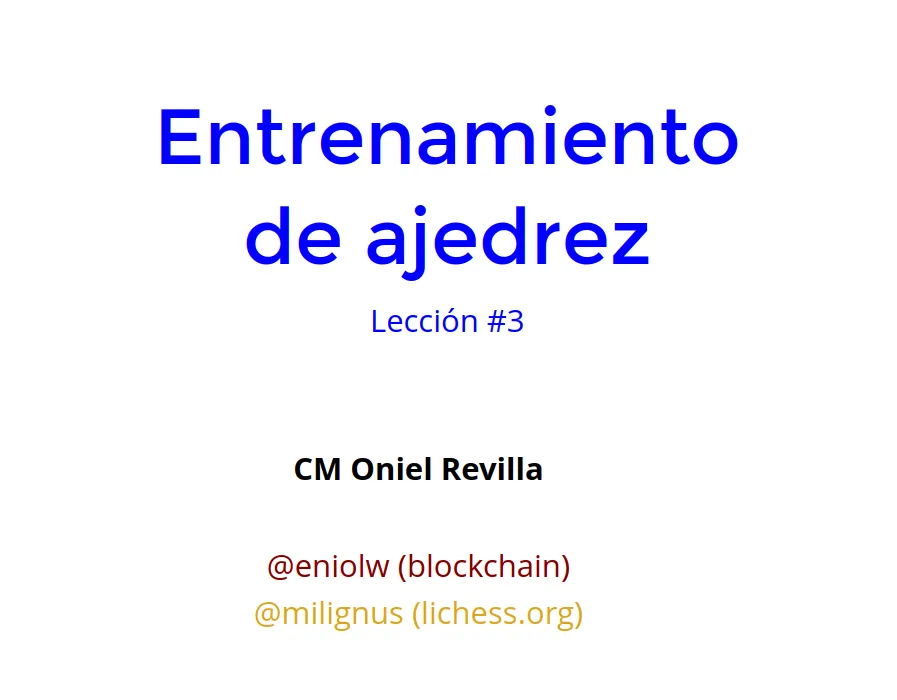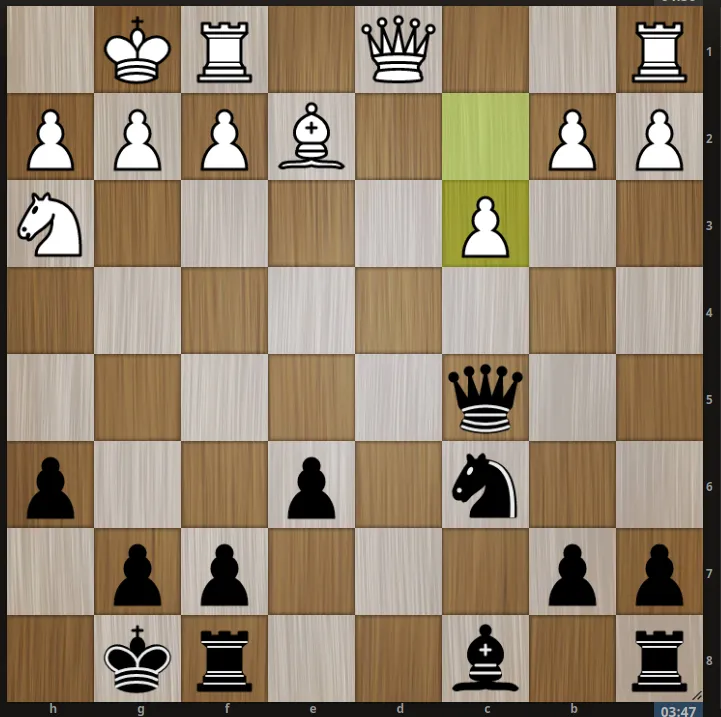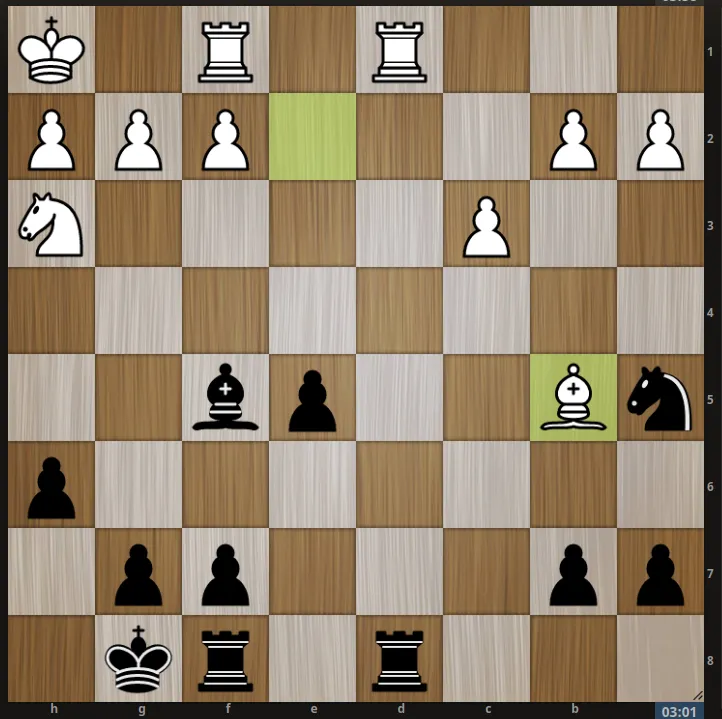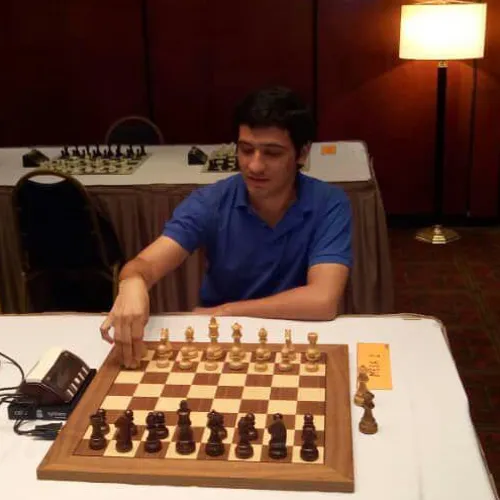
♔ Entrenamiento de Ajedrez 3: Análisis de la partida Jaki01 vs Eniolw (20-8-2021)
(Versión en español | Spanish Version)

Introducción
Hemos dicho que el ajedrez como todo otro deporte requiere de entrenamiento, especialmente cuando nos estamos dedicando seriamente a él y queremos conseguir resultados competitivos. ¿Cómo llevarlo a cabo? Me he propuesto emprender esta serie de videos y de posts sobre entrenamiento de ajedrez, mediante la cual, en mi calidad de entrenador, compartiré algunos consejos para que el lector y audiencia interesada puedan beneficiarse. Analizaremos partidas y posiciones, ejercitaremos distintas habilidades, enseñaremos conceptos ajedrecísticos, usaremos diferentes métodos, y nos orientaremos a todo tipo de jugadores (principiantes, intermedios y avanzados). Espero les agrade.
El caso de entrenamiento
Nuevamente haremos una visión introspectiva mediante el método de análisis de partidas propias, esta vez a mi juego contra el usuario @jaki01, quien resulta ser un fuerte jugador de ajedrez con un rating de Lichess de 2377 puntos. La partida se realizó en la 6ta edición del torneo de HiveChess, temporada en curso. Debemos hacer la salvedad de que este análisis va mayormente enfocado a jugadores avanzados y en él discutiremos algunos conceptos estratégicos, notablemente el de pieza dominada y la subsecuente dominación.
El vídeo del post hace el análisis extensivamente, sin embargo, he extraído algunas posiciones clave que de seguro te serán de utilidad en el entrenamiento. Échales un vistazo y luego compara tus ideas con las soluciones provistas más abajo.

Posición 1: Ya casi comienza el mediojuego. Valora la posición y tras ello formula un plan para las negras (encuentra la solución más abajo o en el vídeo).

Posición 2: Las negras ya están mejor, pero pueden mejorar su posición aún más. ¿De qué manera? (encuentra la solución más abajo o en el vídeo).
Adjunto dejo la transcripción de la partida en formato PGN. Te será de gran utilidad si manejas software de ajedrez:
[Event "Hivechess Tournament Round 6 Arena"]
[Site "https://lichess.org/1fkUlLTr"]
[Date "2021.08.20"]
[White "jaki01"]
[Black "eniolw"]
[Result "0-1"]
[UTCDate "2021.08.20"]
[UTCTime "19:22:28"]
[WhiteElo "2377"]
[BlackElo "2408"]
[WhiteRatingDiff "-5"]
[BlackRatingDiff "+8"]
[Variant "Standard"]
[TimeControl "300+2"]
[ECO "A45"]
[Opening "Trompowsky Attack: Classical Defense"]
[Termination "Time forfeit"]
[Annotator "lichess.org"]
1. d4 Nf6 2. Bg5 e6 { A45 Trompowsky Attack: Classical Defense }
3. Nh3 h6 4. Bh4 c5 5. dxc5 Bxc5 6. Nd2 d5 7. e4 Nc6 8. Be2 O-O
9. O-O dxe4 10. Bxf6 Qxf6 11. Nxe4 Qd4 12. Nxc5 Qxc5 13. c3 e5
14. Kh1 Bf5 15. Qb3 Rad8 16. Rad1 Na5 17. Qb5 Qxb5 18. Bxb5 Bc2
19. Rde1 f6 20. b4 Nc6 21. Re2 Bd3 22. Bxd3 Rxd3 23. Rc2 Rc8
24. a3 b5 25. f4 Nd4 26. Rcf2 Rdxc3 27. fxe5 fxe5 28. Re1 Rxa3
29. Ng1 Re8 30. h4 Rb3 31. Ra2 Re7 32. Kh2 Rxb4 33. Nh3 Rb3
34. Rd2 Rb4 35. Ra2 Kh7 36. Nf2 Rc4 37. Ne4 b4 38. h5 b3
39. Rb2 Rc2 40. Rbb1 b2 41. Ng3 Nf3+ { Black wins on time. } 0-1Discusión a las posiciones planteadas:
¡Ey! ¿Ya has respondido a preguntas planteadas en las posiciones? En ese caso, compara tu respuesta con el siguiente análisis:
Posición 1: Las negras detectan un defecto en la posición blanca, por lo cual juegan 13... e5! Con ello planean aferrarse a un motivo estratético conocido como pieza problemática o pieza torpe. Esto se refiere a la mala ubicación que tiene una pieza, la cual se encuentra generalmente atrapada o aislada y no posee buenas casillas hacia las cuales reposicionarse, por lo menos en el corto plazo. Esto es un problema porque a menudo estorba a las demás piezas de su bando o no ejerce una influencia positiva para su bando, como ayudar a defender o atacar.
En nuestro caso, la pieza problemática de las blancas es el caballo en h3, notablemente aislado de la lucha en el borde desde la tercera jugada. Las negras continuarán entonces con Af5 y concentrar las fuerzas en el centro y el flanco de dama donde la pieza torpe no puede participar, ejerciendo dominación. Alternativamente las negras podrían seguir con ...Axh3, dañando a los peones y el enroque, pero eso sería otro plan. Con el plan sugerido, las negras se asegurarán de tener más influencia en la posición, como si se tratara de un partido de fútbol donde uno de los bandos tiene un jugador lesionado o desubicado en el campo.
Posición 2: Las negras juegan 13... Ac2! forzando al blanco a ceder la columna d que es la única columna abierta en la posición. De esa manera las negras ganan más terreno y con ello posibilidades. El juego por la columna abierta fue también parte de la estrategia negra, pero fue posible gracias a los progresos alcanzados al explotar el tema de la pieza problemática.
Si tienes algo que aportar o debatir, puedes dejarlo en los comentarios.

Sobre el autor:
Soy Oniel Revilla (@eniolw), un ajedrecista venezolano con título de Candidate Master otorgado por la Federación Internacional de Ajedrez (FIDE) en 2016. Poseo más de 20 años de experiencia como deportista y más de 10 años de experiencia como instructor y entrenador de ajedrez. También soy profesor en la Universidad Nacional Experimental Francisco de Miranda. Puedes aprender más sobre mi faceta ajedrecística en esta publicación.
Nota: A menos que se haya indicado lo contrario, las imágenes y vídeos en este post son del autor.

♔ Chess Training 3: Game Analysis of Jaki01 vs Eniolw (Aug 20, 2021)
(English Version | Versión en inglés)

Introduction
(Note: The video that this post features is in Spanish. I don't have a video covering its specific content in English yet, but that might change in the future :)
We've said that chess like any other sport requires training, especially when we are dedicating ourselves seriously to it and we want to achieve competitive results. How to do it though? I have proposed to undertake this series of videos and posts on chess training, through which I will share as a coach some tips so that the reader and interested audience can benefit from them. We will analyze games and positions, exercise different skills, teach chess concepts, use different methods, and orient the coaching to all types of players (beginners, intermediate and advanced). I hope you enjoy it.
Again we will make an introspective view through the method of analysis of own games, this time to my game against the user @jaki01, who happens to be a strong player with a Lichess rating of 2377 points. The game was played in the 6th edition of the HiveChess tournament, current season. It should be noted that this analysis is mostly aimed at advanced players and in it we will discuss some strategic concepts, especially the awkward piece and the subsequent domination.
The video in this post does the analysis extensively, however, I have selected some key positions that are sure to be useful in training. Take a look at them and then compare your thoughts with the solutions provided below.

Position 1: The middlegame is almost beginning. Evaluate the position and then come up with a plan for black. (Find the solution below or in the video if you understand Spanish.)

Position 2: Black is already better, but he can improve his position even more. How? (Find the solution below or in the video if you understand Spanish.)
Attached is the transcript of the game in PGN format. It will be very useful if you use chess software:
[Event "Hivechess Tournament Round 6 Arena"]
[Site "https://lichess.org/1fkUlLTr"]
[Date "2021.08.20"]
[White "jaki01"]
[Black "eniolw"]
[Result "0-1"]
[UTCDate "2021.08.20"]
[UTCTime "19:22:28"]
[WhiteElo "2377"]
[BlackElo "2408"]
[WhiteRatingDiff "-5"]
[BlackRatingDiff "+8"]
[Variant "Standard"]
[TimeControl "300+2"]
[ECO "A45"]
[Opening "Trompowsky Attack: Classical Defense"]
[Termination "Time forfeit"]
[Annotator "lichess.org"]
1. d4 Nf6 2. Bg5 e6 { A45 Trompowsky Attack: Classical Defense }
3. Nh3 h6 4. Bh4 c5 5. dxc5 Bxc5 6. Nd2 d5 7. e4 Nc6 8. Be2 O-O
9. O-O dxe4 10. Bxf6 Qxf6 11. Nxe4 Qd4 12. Nxc5 Qxc5 13. c3 e5
14. Kh1 Bf5 15. Qb3 Rad8 16. Rad1 Na5 17. Qb5 Qxb5 18. Bxb5 Bc2
19. Rde1 f6 20. b4 Nc6 21. Re2 Bd3 22. Bxd3 Rxd3 23. Rc2 Rc8
24. a3 b5 25. f4 Nd4 26. Rcf2 Rdxc3 27. fxe5 fxe5 28. Re1 Rxa3
29. Ng1 Re8 30. h4 Rb3 31. Ra2 Re7 32. Kh2 Rxb4 33. Nh3 Rb3
34. Rd2 Rb4 35. Ra2 Kh7 36. Nf2 Rc4 37. Ne4 b4 38. h5 b3
39. Rb2 Rc2 40. Rbb1 b2 41. Ng3 Nf3+ { Black wins on time. } 0-1Discussions of the previous positions:
¡Hey! Have you already answered the questions asked about the positions? If so, compare your answers with the following analysis!
Position 1: Black spots a flaw in white's position, so he plays 13.... e5! With it, the player plans to hold on to a chess strategical motif known as the problematic piece or the awkward piece. This refers to the poor placement of a piece, which is usually trapped or isolated and has no good squares to reposition to, at least in the short term. This is a problem because it often gets in the way of the other pieces on its side or does not exert a positive influence for its side, such as helping to defend or attack.
In our case, white's awkward piece is the knight on h3, notably isolated from the fight on the edge since the third move. Black will then continue with Bf5 and concentrate forces on the center and the queenside where the awkward piece cannot participate, exerting domination. Alternatively, black could follow with ...Bxh3, ruining white's pawns and castle, but that would be another plan. The plan chosen in the game will ensure that the black pieces will have more influence in the position, as if it were a soccer match where one of the sides has an injured or misplaced player on the field.
Position 2: Black plays 13... Bc2! forcing white to give up the d-file, which is the only open file in the position. In this way, black gains more ground and with it more possibilities. The play on the open file was also part of black's strategy, but it was only possible thanks to the progress made by exploiting the awkward piece theme.
If you have something to share or debate, feel free to leave it in the comments.

About the author:
I am Oniel Revilla (@eniolw), a Venezuelan chess player with the title of Candidate Master awarded by the International Chess Federation (FIDE) in 2016. I have over 20 years of experience as a professional chess player and over 10 years of experience as a chess teacher and coach. I am also a professor at the Universidad Nacional Experimental Francisco de Miranda. You can learn more about my chess facet in this post.
Note: Unless otherwise noted, the images and videos in this post belong to the author.
▶️ 3Speak
